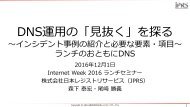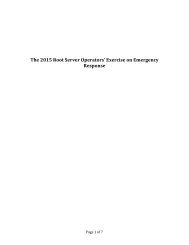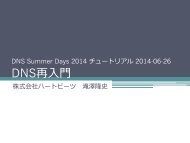You also want an ePaper? Increase the reach of your titles
YUMPU automatically turns print PDFs into web optimized ePapers that Google loves.
organizations that operate as widely-trusted certification authorities (i.e., those with root<br />
certificates embedded in browsers and OSs); and<br />
web browser and other software v<strong>en</strong>dors.<br />
3.4.2 Data sources and root server assistance<br />
Preliminary discussions on the practicalities of this study took place during the RIPE66 and<br />
DNS-OARC meetings in mid-May 2013 since several of the RSOs were att<strong>en</strong>ding. These<br />
discussions considered what data would be needed for the study, how to collect and deliver that<br />
data, likely timelines/milestones, and what levels of assistance the RSOs could provide.<br />
The cons<strong>en</strong>sus was that the main data source for DNS analysis should be DNS-OARC’s DITL<br />
(Day in the life of the Internet) 15 data sets. Many RSOs already contributed data to that initiative<br />
and had begun preparations for the 2013 DITL exercise which would start later that month.<br />
Using DITL data for this study had the b<strong>en</strong>efit of not requiring RSOs to commit resources for<br />
some other type of data gathering. In addition, access to the DITL data was covered by a single<br />
data sharing agreem<strong>en</strong>t common to all DNS-OARC members. This meant that the study team<br />
would be able to analyze those data almost immediately and avoid the pot<strong>en</strong>tial delays that might<br />
arise from the legal complexities of arranging confid<strong>en</strong>tiality and/or data access agreem<strong>en</strong>ts with<br />
individual root server operators.<br />
3.4.3 DITL data processing<br />
The sheer size of the DITL data sets pres<strong>en</strong>ted many chall<strong>en</strong>ges; managing roughly 8TB of<br />
compressed data spread across more than 500,000 files and organizing the workflow around<br />
them was a non-trivial exercise. All of this work had to be performed at DNS-OARC under the<br />
terms of its data sharing agreem<strong>en</strong>t. DITL data could not be copied or moved off-site; they could<br />
be accessed only across the local network from DNS-OARC’s file servers.<br />
Before any data gathering was carried out, the team made an assessm<strong>en</strong>t of the available<br />
hardware at DNS-OARC and the pot<strong>en</strong>tial software that could be used. Some b<strong>en</strong>chmarking was<br />
done to assess the hardware or network footprint of these tools and how long particular tools<br />
would take to process the data. Pragmatic choices were th<strong>en</strong> made about how best to proceed—<br />
which tools would be most suited to the available platforms; what approaches to processing the<br />
data would and would not work well; how to arrange the workflows; and estimating how long<br />
each run over the data sets would take. Appropriate scripts were th<strong>en</strong> developed and tested.<br />
These produced summary results which were submitted for statistical analysis.<br />
15 https://www.dns-oarc.net/oarc/data/ditl<br />
Name Collision Study Report Page 18<br />
Version 1.5 2013.08.02







